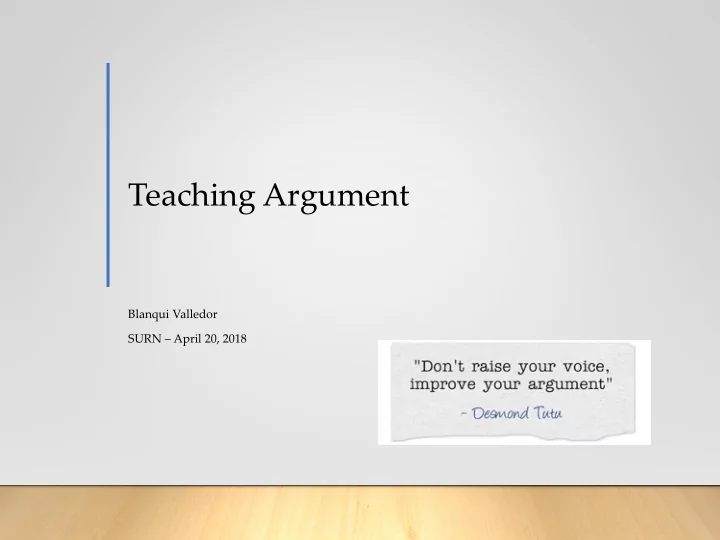

Teaching Argument Blanqui Valledor SURN – April 20, 2018
Introducing Argument
Amy’s Murder
Discussion – Who Dunnit?
Persuasion versus Argument
Subtle, but Significant differences between.. The Goals: Persuasive Argumentative To get reader to agree with you/your point of view To get reader to acknowledge that your side is valid on a particular topic. and deserves consideration as another point of view.
Subtle, but Significant differences between.. General Technique: Persuasive Argumentative Blends facts and emotion in attempt to convince the Offers the reader relevant reasons, credible facts, reader that the writer is “right.”(Often relies heavily and sufficient evidence to honor the writer has a on opinion.) valid and worthy perspective.
Subtle, but Significant differences between.. Starting Point: Persuasive Argumentative Identify a topic and your side. Research a topic and then align with one side.
Subtle, but Significant differences between.. Viewpoint: Persuasive Argumentative Persuasion has a single-minded goal . It is based on a Acknowledge that opposing views exist , not only to personal conviction that a particular way of thinking hint at what a fair-minded person you are, but to is the only sensible way to think. Writer presents one give you the opportunity to counter these views side — his side. tactfully in order to show why you feel that your own view is the more worthy one to hold. (Persuasive writing may include ONE opposing point, it is then quickly dismissed/refuted.) Writer presents multiple perspectives, although is clearly for one side.
Subtle, but Significant differences between.. Audience: Persuasive Argumentative Needs intended audience. Knowing what they think Doesn’t need an audience to convince. The writer is and currently believe, the writer “attacks” content with simply putting it out there. attempting to persuade them to his side.
Subtle, but Significant differences between.. Attitude: Persuasive Argumentative Persuasive writers want to gain another “vote” so Simply to get the reader to consider you have an idea they “go after” readers more aggressively. Persuasive worthy of listening to. The writer is sharing a writing is more personal, more passionate, more conviction, whether the audience ends up agreeing emotional. or not.
Activity (3-5 minutes) • Now as a group, REVIEW YOUR CONCLUSIONS On THE mystery of Amy’s murder. Did you use any of the argumentative techniques discussed? • If so, which ones?
Counterarguments • Exposes the weaknesses in the opposing position. • Anticipate the weaknesses in your own argument that opponents will try to expose, and provide some defense for them. Acknowledging potential weaknesses can sometimes lead you to qualify or adjust your position, thus strengthening it.
Counterarguments • Counter-argument in an essay has two stages: • you turn against your argument to challenge it • and then you turn back to re-affirm it. • You first imagine a skeptical reader, or cite an actual source, who might resist your argument by pointing out problem or disadvantage.
Activity (1-3 minutes) • Based on our discussion about Amy’s Murder, what are some examples of counter argument?
Activity (10-15) • Let’s practice • Watch the following video • Paying Students for Grades
Part 1 - Argument • Would students do better in school if they received monetary compensation for their grades?
Part 2 – Select a Side • What is your response? • Yes • No • Maybe • Select one and move to that section of the room.
Part 3 - Discussion (5-7 minutes) • Select an individual to be the note taker. You are responsible for writing down your group’s findings. • Discuss with the members of your group the reasons you said Yes, No, or Maybe.
Activity 4 – Share Out (5 – 10 minutes) • Each group with have 1-2 minutes to share with the class their argument. • No one is to make comments or object. Everyone should be taking notes of the each group’s argument. • At this time if any group has made a strong argument and has changed your mind, please move to that group.
Part 5 – Reflection (10 minutes) • Using the notes you took, write a concise paragraph stating your position on the issue. • For example, I agree or disagree with the statement [statement goes here] because… • You must include at least two points made by the other groups in your counter argument.
Socratic Seminar
• Cats are the best pets. • Yes, No, Maybe
Should professional athletes be allowed to kneel during the National Anthem?
Socrates believed that enabling students to think for themselves was more important than filling their heads with “right answers.”
The Vision Participants seek deeper understanding of complex ideas through rigorously thoughtful dialogue , rather than by memorizing bits of information.
Benefits include: • Time to engage in in-depth discussions, problem solving, and clarification of ideas. • Building a strong, collaborative work culture. • Enhanced knowledge and research base. • Teaching respect for diverse ideas, people, and practices. • Creating a positive learning environment for all students.
5 Steps to an Effective Socratic Seminar 1 2 3 4 5 Select an Develop group Hold the Reflect. Prepare students. appropriate text. norms. seminar.
The Text • Socratic Seminar texts are chosen for their richness in ideas, issues, and values, and their ability to stimulate extended, thoughtful dialogue . • A good text raises important questions • There are no right or wrong answers.
The Text A seminar text can be drawn from readings in literature, history, science, math, health, and philosophy or from works of art or music.
The Question: A Socratic Seminar opens with a Question posed by the leader or solicited from participants as they acquire more experience in seminars. Responses to the opening question generate new questions from the leader and participants, leading to new responses.
Videos of Socratic Seminars • Socratic Seminar focused on poetic language: https://www.teachingchannel.org/videos/bring- socratic-seminars-to-the-classroom • Socratic seminar using claims and counterclaims: https://www.teachingchannel.org/videos/using- socratic-seminars-in-classroom
Questions?
Recommend
More recommend